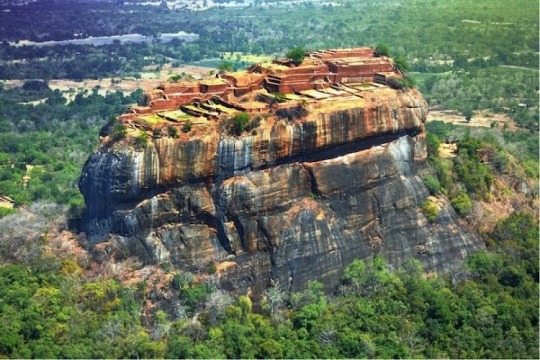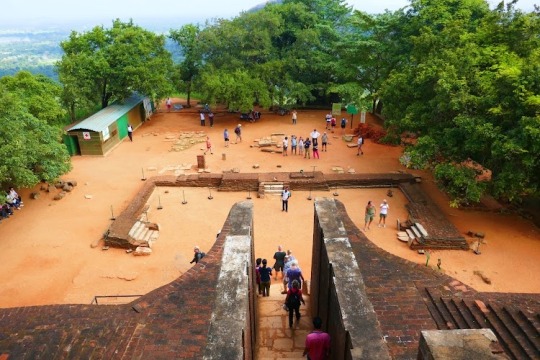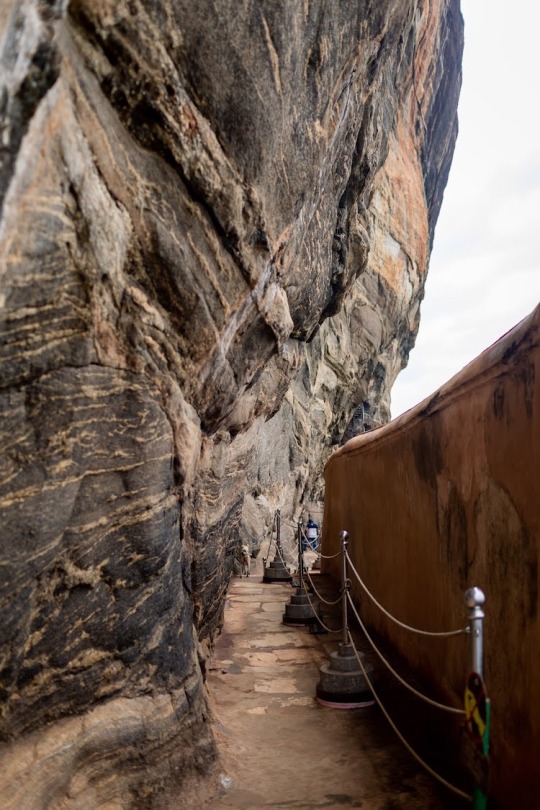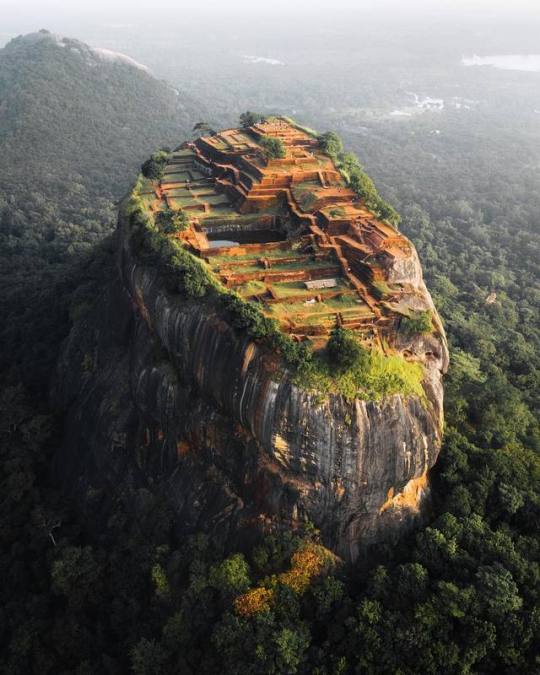#sinhagiri
Text

Sigiriya Rock - SRI LANKA
47 notes
·
View notes
Photo

Sigiriya Fortress
Sigiriya, aka Sinhagiri, is an ancient rock fortress in Sri Lanka. According to the ancient chronicles, this area was a large forest; however, it became a hill after the storms and landslides. Then, the hill became the new capital of Sri Lanka in the 5th century AD. King Kashyapa (477- 495) built a palace decorated with frescoes on top of it. He also built a gateway in the shape of an enormous lion on a plato leading to the palace. This gateway also gave the fortress its name, “Sinhagiri,” meaning the lion rock.
Photo: jordhammond
#sigiriya fortress#fortress#sinhagiri#rock fortress#sri lanka#history#king kashyapa#palace#frescoes#lion rock#jordhammond
4 notes
·
View notes
Text
¿Historias cortas para no dormir y así no tener pesadillas?
¿Piedras viejas o viejas piedras?
Sigiriya o Sinhagiri (/ˈsiːgirijə/) es un yacimiento arqueológico localizado en el distrito de Matale, en la provincia Central, de Sri Lanka. Contiene las ruinas de un antiguo complejo palaciego, construido durante el reino del rey Kasyapa (477 – 495). Es uno de los destinos turísticos más populares del país. Fue declarado lugar Patrimonio de la Humanidad por la Unesco en el año 1982.1
Sigiriya se presume haber sido habitada desde tiempos prehistóricos. Fue utilizada como un monasterio enclavado en la roca desde el Siglo III, con cavernas preparadas y donadas por devotos budistas.1

El Jardín y el palacio fueron hechos construir por Kasyapa. Después de la muerte de Kasyapa, siguió siendo un complejo monástico hasta el siglo XIV, tras lo cual fue abandonado. Las ruinas fueron descubiertas en 1908 por el explorador británico John Still. Las inscripciones Sigiri fueron descifradas por el arqueólogo Paranavithana quien publicó un renombrado trabajo en dos volúmenes, publicado en Oxford, conocido como "Los glifos de Sigiri". Él mismo escribió el popular libro "Historia de Sigiriya".
#¿Piedras viejas o viejas piedras? Sigiriya o Sinhagiri (/ˈsiːgirijə/) es un yacimiento arqueológico localizado en el distrito de Matale en#¿Historias cortas para no dormir?
1 note
·
View note
Text


Sigiriya, Sri Lanka by sander traa
Sigiriya or Sinhagiri is an ancient rock fortress located in the northern Matale District near the town of Dambulla in the Central Province, Sri Lanka. It is a site of historical and archaeological significance that is dominated by a massive column of granite approximately 180 m high.
#mountains#sri lanka#nature#curators on tumblr#aerial photography#history#travel#photography#uploads
303 notes
·
View notes
Text

Sigiriya Rock - sigiriya, SriLanka
Sigiriya rock is about 200 meters in height and is a UNESCO listed World Heritage Site. The rock has great historical and archaeological significance and is widely known as the eighth wonder of the world. Sigiriya Rock was used by the ancient King Kashyapa as his Royal Palace. The king used it as a hideout and a way of protecting himself and his kingdom from enemies. Sigiriya Rock is one of the best preserved examples of ancient urban planning. Photo credit @chocodolly_walker
#travel#tourism#srilanka#attractionsinsrilanka#travel photography#beautifuldestinations#sigiriya#history#travel ideas#travel destinations#best travel blogs
2 notes
·
View notes
Text










Sigiriya
Sigiriya or Sinhagiri (Lion Rock Sinhala: සීගිරිය, Tamil: சிகிரியா/சிங்ககிரி, pronounced see-gi-ri-yə) is an ancient rock fortress located in the northern Matale District near the town of Dambulla in the Central Province, Sri Lanka. It is a site of historical and archaeological significance that is dominated by a massive column of rock approximately 180 m (590 ft) high.[2]
Sigiriya
Aerial view of Sigiriya Rock
Location
Central Province, Sri Lanka
Coordinates
07°57′25″N 80°45′35″E
Elevation
349 m (1,145 ft)[1]
Built for
King Kashyapa of Sri Lanka
Visitors
1 million
Governing body
Government of Sri Lanka
Website
www.sigiriyafortress.com
UNESCO World Heritage Site
Official name
Ancient City of Sigiriya
Type
Cultural
Criteria
ii, iii, iv
Designated
1982 (6th session)
Reference no.
202
UNESCO Region
Asia-Pacific
Location of Sigiriya in Sri Lanka
According to the ancient Sri Lankan chronicle the Cūḷavaṃsa, this area was a large forest, then after storms and landslides it became a hill and was selected by King Kashyapa (AD 477–495) for his new capital. He built his palace on top of this rock and decorated its sides with colourful frescoes. On a small plateau about halfway up the side of this rock he built a gateway in the form of an enormous lion. The name of this place is derived from this structure; Sīnhāgiri, the Lion Rock (an etymology similar to Sinhapura, the Sanskrit name of Singapore, the Lion City).
The capital and the royal palace were abandoned after the king's death. It was used as a Buddhist monastery until the 14th century.[3] Sigiriya today is a UNESCO listed World Heritage Site. It is one of the best preserved examples of ancient urban planning.[4]
History
Historical past
It is likely that the area around Sigiriya may have been inhabited since prehistoric times. There is clear evidence that the many rock shelters and caves in the vicinity were occupied by Buddhist monks and ascetics from as early as the 3rd century BC. The earliest evidence of human habitation at Sigiriya is the Aligala rock shelter to the east of Sigiriya rock, indicating that the area was occupied nearly five thousand years ago during the Mesolithic Period.
Buddhist monastic settlements were established during the 3rd century BC in the western and northern slopes of the boulder-strewn hills surrounding the Sigiriya rock. Several rock shelters or caves were created during this period. These shelters were made under large boulders, with carved drip ledges around the cave mouths. Rock inscriptions are carved near the drip ledges on many of the shelters, recording the donation of the shelters to the Buddhist monastic order as residences. These were made in the period between the 3rd century BCE and the 1st century AD.
In 477 AD, Kashyapa I, the king’s son by a non-royal consort, seized the throne from King Dhatusena, following a coup assisted by Migara, the King’s nephew and army commander. The rightful heir, Moggallana, fearing for his life, fled to South India. Afraid of an attack by Moggallana, Kashyapa moved the capital and his residence from the traditional capital of Anuradhapura to the more secure Sigiriya. During King Kashyapa’s reign (477 to 495 AD), Sigiriya was developed into a complex city and fortress.[3][4] Most of the elaborate constructions on the rock summit and around it, including defensive structures, palaces, and gardens, date from this period.
The Cūḷavaṃsa describes King Kashyapa as the son of King Dhatusena. Kashyapa murdered his father by walling him up alive and then usurping the throne which rightfully belonged to his half-brother Moggallana, Dhatusena's son by the true queen. Moggallana fled to India to escape being assassinated by Kashyapa, but vowed revenge. In India he raised an army with the intention of returning and retaking the throne of Sri Lanka, which he considered to be rightfully his. Expecting the inevitable return of Moggallana, Kashyapa is said to have built his palace on the summit of Sigiriya as a fortress as well as a pleasure palace. Moggallana finally arrived, declared war, and defeated Kashyapa in 495 CE. During the battle Kashyapa's armies abandoned him and he committed suicide by falling on his sword.
The Cūḷavaṃsa and folklore inform us that the battle-elephant on which Kashyapa was mounted changed course to take a strategic advantage, but the army misinterpreted the movement as the king's having opted to retreat, prompting the army to abandon him altogether. It is said that being too proud to surrender he took his dagger from his waistband, cut his throat, raised the dagger proudly, sheathed it, and fell dead. Moggallana returned the capital to Anuradhapura, converting Sigiriya into a Buddhist monastery complex,[5] which survived until the 13th or 14th century. After this period, no records are found on Sigiriya until the 16th and 17th centuries, when it was used briefly as an outpost of the Kingdom of Kandy.
<img src="//upload.wikimedia.org/wikipedia/commons/thumb/1/1f/Sigiriya_Luftbild_%2829781064900%29.jpg/450px-Sigiriya_Luftbild_%2829781064900%29.jpg" decoding="async" width="450" height="253" class="thumbimage" data-file-width="3241" data-file-height="1820">
Sigiriya Rock from above
Alternative stories have the primary builder of Sigiriya as King Dhatusena, with Kashyapa finishing the work in honour of his father. Still other stories describe Kashyapa as a playboy king, with Sigiriya his pleasure palace. Even Kashyapa's eventual fate is uncertain. In some versions he is assassinated by poison administered by a concubine; in others he cuts his own throat when deserted in his final battle.[6] Still further interpretations regard the site as the work of a Buddhist community, without a military function. This site may have been important in the competition between the Mahayana and Theravada Buddhist traditions in ancient Sri Lanka.
In Professor Senarath Paranavithana's book The Story of Sigiriya, King Dathusena is said to have taken the advice of the Persian Nestorian Priest Maga Brahmana on building his palace on Sigirya. According to Paranavithana, during this period over seventy-five ships carrying Murundi soldiers from Mangalore arrived in Sri Lanka and landed in Chilaw to protect King Dathusena, most of them Christians. King Dathusena's daughter was married to Migara, a Christian and the commander of the Singhalese army
0 notes
Text
Sigiriya in Sri Lanka
In the northern Matale District of the Central Province of Sri Lanka, close to the town of Dambulla, sits the historic rock fortification known as Sigiriya or Sinhagiri. It is a location with historical and archaeological value that is dominated by a huge granite column that stands 180 meters (590 feet) tall.
This location was once a vast forest, but due to storms and landslides, it was transformed into a hill, and King Kashyapa (477–495 AD) chose it as the site of his new capital. On top of this rock, he constructed his palace, which he then painted with vibrant frescoes. He constructed a huge lion-shaped doorway on a little plateau approximately halfway up the side of this rock. This building gave this location its name, Snhgiri, or the Lion Rock (an etymology similar to Sinhapura, the Sanskrit name of Singapore, the Lion City).
Read more:
Join us:
Facebook - https://www.facebook.com/Zeloantravel
Pinterest - https://www.pinterest.com/Zeloantravel/
TikTok - https://www.tiktok.com/@zel0an
Instagram - https://www.instagram.com/zeloantravel/
Twitter - https://twitter.com/Zeloantravel
LinkedIn - https://www.linkedin.com/in/zeloan-travel-b68b27243/
Tumblr - https://www.tumblr.com/blog/zeloan
Blogger - https://zeloan.blogspot.com/
Flicker - https://flic.kr/ps/3Z8ugG
Imgur - https://imgur.com/user/ZeloanTravel
Flipboard - https://flipboard.com/@ZeloanTravel
VK - vk.com/id735880267
YouTube - https://www.youtube.com/channel/UC5XRFZyJIy9LCdB4eT11Tbg
Medium - https://medium.com/@Zeloantravel
Reddit - https://www.reddit.com/user/NavinRuvinda
Quora - https://www.quora.com/profile/Zeloan
0 notes
Photo

Sigiriya or Sinhagiri is an ancient stone fortress & most valuable historical monuments, located in the Matale district near the town of Dambulla in the North Central Province of Sri Lanka. Sigiriya is considered by many to be the eighth wonder of the world. It reaches 660 feet tall and features frescoes, graffiti and landscaped gardens. The place is part of the list of UNESCO World Heritage sites since 1982.
#Sigiriya#Sinhagiri#SriLanka#ancient#mountain#nature#mountains#landscape#travel#hiking#trekking#adventure#naturelovers#outdoor#explore#climbing#wanderlust#lifelonglearner#lifelonglearners#outdoors#vacation#amazing
51 notes
·
View notes
Photo

Sigiriya Rock in Sri Lanka
Drone photo by Jordan Hammond.
#drone#aerial photography#sri lanka#unesco#8th wonder of the world#uav#sigiriya#sinhagiri#dronestagram#dji#aerial perspective#natural#earth#rock#forest#green#natural earth#aerial view#travel#asia
55 notes
·
View notes
Photo

Sigiriya or Sinhagiri is an ancient rock fortress located in the northern Matale… Sigiriya or Sinhagiri is an historic rock fortress positioned within the northern Matale District close to the city of Dambulla within the Central Province, Sri Lanka. The title refers to a website of historic and archaeological significance that's dominated by a large column of rock practically 200 metres excessive
0 notes
Photo

#THROWBACK #Sigiriya or #Sinhagiri meaning #LionRock is an #ancient #rock fortress located in the northern Matale District near the town of #Dambulla in the Central Province, #SriLanka. #AddictedtoTravel #naturelover #TravelwithmioK #landscape #landscapelovers #worldtraveler #travel #traveler (at Sigiriya, Sri Lanka)
#throwback#srilanka#travel#lionrock#travelwithmiok#landscape#ancient#dambulla#traveler#rock#addictedtotravel#landscapelovers#sigiriya#naturelover#sinhagiri#worldtraveler
0 notes
Text
¿Historias cortas para no dormir y así no tener pesadillas?
¿Piedras viejas o viejas piedras?
Sigiriya o Sinhagiri (/ˈsiːgirijə/) es un yacimiento arqueológico localizado en el distrito de Matale, en la provincia Central, de Sri Lanka. Contiene las ruinas de un antiguo complejo palaciego, construido durante el reino del rey Kasyapa (477 – 495). Es uno de los destinos turísticos más populares del país. Fue declarado lugar Patrimonio de la Humanidad por la Unesco en el año 1982.1
Sigiriya se presume haber sido habitada desde tiempos prehistóricos. Fue utilizada como un monasterio enclavado en la roca desde el Siglo III, con cavernas preparadas y donadas por devotos budistas.1

El Jardín y el palacio fueron hechos construir por Kasyapa. Después de la muerte de Kasyapa, siguió siendo un complejo monástico hasta el siglo XIV, tras lo cual fue abandonado. Las ruinas fueron descubiertas en 1908 por el explorador británico John Still. Las inscripciones Sigiri fueron descifradas por el arqueólogo Paranavithana quien publicó un renombrado trabajo en dos volúmenes, publicado en Oxford, conocido como "Los glifos de Sigiri". Él mismo escribió el popular libro "Historia de Sigiriya".
#¿Piedras viejas o viejas piedras? Sigiriya o Sinhagiri (/ˈsiːgirijə/) es un yacimiento arqueológico localizado en el distrito de Matale en#¿Historias cortas para no dormir?
0 notes
Photo

Sigiriya or Sinhagiri (Lion Rock Sinhala: සීගිරිය, Tamil: சிகிரியா / aசிங்ககிரி, pronounced see-gi-ri-yə) is an ancient rock fortress located in the northern Matale District near the town of Dambulla in the Central Province, Sri Lanka. The name refers to a site of historical and archaeological significance that is dominated by a massive column of rock nearly 200 metres (660 ft) high
67 notes
·
View notes
Text

Lion’s Rock fortress - Sigiriya, SriLanka
Sigiriya also known as “Sinhagiri” or “Lion’s Rock” is an ancient rock fortress situated in Sigiriya town near the town of Dambulla in the Central Province of Sri Lanka. Sigiriya rock is about 200 meters in height and is a UNESCO listed World Heritage Site. The rock has great historical and archaeological significance and is widely known as the eighth wonder of the world.
#travel#srilanka#tourism#nature#travel photography#photography#ancient#historical#traveller#thumblr#attractionsinsrilanka#hike#beautifuldestinations#travel ideas#travel destinations#traveling#history#sigiriya
23 notes
·
View notes
Photo

Sigiriya or Sinhagiri is an ancient rock fortress located in Sri Lanka.
1 note
·
View note